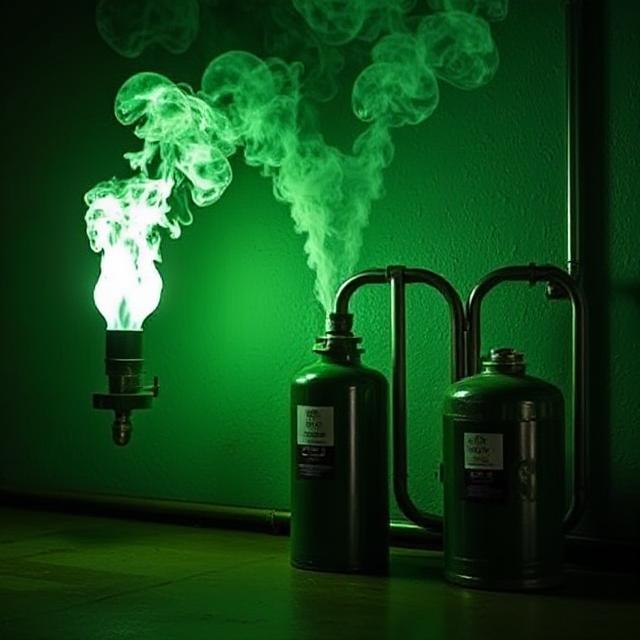Introduction
Argon gas, a noble gas with the symbol Ar and atomic number 18, is renowned for its inertness and versatility across various industries. Its unique properties make it indispensable in applications ranging from manufacturing to scientific research. This article delves into the multifaceted uses of argon gas, highlighting its significance in 2025 and beyond.

What Is Argon Gas?
Argon is a colorless, odorless, and tasteless gas that constitutes about 0.93% of the Earth’s atmosphere. Being chemically inert, it does not readily react with other substances, making it ideal for applications requiring a non-reactive environment.
Key Properties:
- Atomic Number: 18
- Atomic Weight: 39.948
- Boiling Point: -185.9°C
- Melting Point: -189.2°C
- Density: 1.784 kg/m³
Industrial Applications of Argon
Welding and Metal Fabrication
Argon is extensively used as a shielding gas in welding processes such as Gas Tungsten Arc Welding (GTAW) and Gas Metal Arc Welding (GMAW). Its inert nature prevents oxidation and contamination of the weld area, ensuring high-quality joints. (Wikeeps)
Benefits:
- Prevents oxidation during welding
- Ensures cleaner welds with fewer defects
- Suitable for welding reactive metals like aluminum and titaniumnexAir
Semiconductor and Electronics Manufacturing
In the semiconductor industry, argon provides an inert atmosphere during the fabrication of silicon wafers and other components. It is also used in sputtering processes for thin-film deposition. (airproducts.expert)
Applications:
- Sputtering gas for thin-film deposition
- Purge gas in crystal growth reactors
- Maintains contamination-free environments in manufacturing chambers
Lighting and Optics
Argon is utilized in incandescent and fluorescent lighting to prevent filament oxidation, thereby extending bulb life. It is also employed in gas-discharge tubes and lasers.
Uses:
- Filling gas in incandescent bulbs
- Medium in argon-ion lasers for medical and industrial applications
- Component in plasma globes and other decorative lighting
Scientific and Medical Applications
Medical Procedures
Argon plays a role in various medical applications, including cryosurgery and laser surgeries. Its inertness and ability to maintain low temperatures make it suitable for these procedures. (nexAir)
Applications:
- Cryosurgery for tissue removal
- Argon plasma coagulation in endoscopic procedures
- Component in certain medical lasers
Laboratory Uses
In research laboratories, argon is used to create inert atmospheres for sensitive experiments. It serves as a carrier gas in gas chromatography and is essential in mass spectrometry techniques like Inductively Coupled Plasma Mass Spectrometry (ICP-MS).
Benefits:
- Prevents unwanted chemical reactions
- Ensures accuracy in analytical measurements
- Maintains sample integrity during analysis
Environmental and Energy Applications
Thermal Insulation
Argon gas is used in double-glazed windows to enhance thermal insulation. By filling the space between panes, it reduces heat transfer, leading to improved energy efficiency in buildings.
Advantages:
- Reduces energy loss by up to 30%
- Enhances indoor comfort
- Lowers heating and cooling costs
Nuclear Applications
In nuclear reactors, argon serves as a neutron absorber and provides an inert environment to prevent unwanted chemical reactions. Its properties are crucial for maintaining safety and efficiency in nuclear operations.
Roles:
- Neutron absorption in fast breeder reactors
- Inert atmosphere in nuclear fuel processing
- Cooling medium in certain reactor designs
Specialized and Niche Uses
Preservation and Archiving
Argon is employed to preserve historical documents and artifacts by displacing oxygen and moisture, which can cause degradation. Institutions like the National Archives use argon-filled cases to protect valuable items.
Benefits:
- Prevents oxidation and decay
- Extends the lifespan of preserved items
- Non-reactive environment ensures material integrity
Analytical Chemistry
In analytical chemistry, argon acts as a carrier gas in techniques like ICP-MS, aiding in the detection of trace elements in various samples. Its inertness ensures that it does not interfere with the analysis.
Applications:
- Trace metal analysis in environmental samples
- Quality control in pharmaceutical manufacturing
- Research in material sciences
Safety and Handling of Argon Gas
While argon is non-toxic and non-flammable, it can pose asphyxiation risks in confined spaces due to oxygen displacement. Proper safety measures are essential when handling and storing argon gas.
Safety Guidelines:
- Ensure adequate ventilation in storage and usage areas
- Use oxygen monitors in confined spaces
- Store cylinders upright and secure them to prevent tipping
- Follow OSHA and Compressed Gas Association (CGA) guidelines(mckinneynyc.com, osha.oregon.gov)
YiGas Argon Gas: Product Overview

YiGas offers high-purity argon gas tailored for various industrial and scientific applications.
Key Features:
- Suitable for advanced manufacturing, including TIG/MIG welding
- Ideal for semiconductor fabrication and electronics manufacturing
- Used in LED/OLED deposition and laser systems
- Enhances thermal insulation in building applications
- Serves as a neutron absorber in nuclear reactors
- Acts as a preservative gas for archival storage
- Functions as a carrier gas in ICP-MS environmental analysis.
Safety and Compliance:
- Asphyxiation risk above 75% concentration; adhere to OSHA guidelines
- Cryogenic handling requires ASTM F968-compliant PPE
- Available in DOT/ADR cylinders or bulk liquid delivery with real-time purity monitoring
Product Specifications:
- CAS Number: 7440-37-1
- UN Number: 1004
- EINECS Number: 231-1472-0
- Molecular Weight: 39.948
- Appearance: Colorless, odorless
- Melting Point: -189.2°C
- Boiling Point: -185.9°C
- Density: 1.784 kg/m³
- DOT Class: 2.2
- Label: Non-flammable Gas

